Return to
the Main Page.
MATTHEW FARRER - Crossfire Black Library /Games Workshop Ltd.; paperback original; part of the Warhammer 40,000 series; 1st US printing, July 2003. 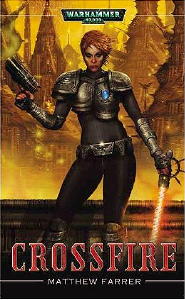 I confess that I haven’t
read any of the other books in the series, but what it seems to be is a
far-future set of novels taking place in a universe ruled by the
Emperor’s Imperial Guard, the “ever-vigilant Inquisition” and the
“tech-priests of the Adeptus Mechanicus.” Lots of bloody warfare,
I gather, with “no peace amongst the stars, only an eternity of carnage
and slaughter, and the laughter of thirsting gods.” I confess that I haven’t
read any of the other books in the series, but what it seems to be is a
far-future set of novels taking place in a universe ruled by the
Emperor’s Imperial Guard, the “ever-vigilant Inquisition” and the
“tech-priests of the Adeptus Mechanicus.” Lots of bloody warfare,
I gather, with “no peace amongst the stars, only an eternity of carnage
and slaughter, and the laughter of thirsting gods.”Maybe it’s a video game, too, or maybe I have it all wrong. In any case, if you haven’t already skipped this review and gone on to the next one, the small incident on an isolated planetary system that this novel is about has both a crime, or a series of crimes, and an active detective whose career seems to be only beginning. Really. Stay with me, and I’ll tell you what I mean. What caught my eye first was the cover. A punkish young lady with reddish, short cropped hair, dressed mostly in shiny black – either leather or metal, or a combination thereof – holding a light saber of some sort in one hand and a huge pistol-looking affair in the other. Her name is Shira Calpurnia, and she is the newly arrived Arbites officer on the planet Hydraphur. From the first sentence on, we know, hey Jenny, we’re not in Kansas any more, when she meets Genator-Magos Cynez Sanja, of the Order Biologis: The machine cultists of the Adeptus
Mechanicus are not prone to strong emotions – the beautiful coldness of
the Machine is held up as a model for admiration and emulation, even
for those orders of the Mechanicus not directly concerned with physical
mechanics and the gradual transfiguration of their own bodies into
cybernetics.
An attempt to assassinate Shira is made soon thereafter, and hunting down the miscreants responsible takes the remainder of the book, which consists of 320 pages of very small print, and baroque prose nearly always as dense as the short extract above. Or as below, taken from page 51: The Augustaeum, nestled within its walls
at the peak of the Bosporian hive, was not flat – its sides kept
sloping up to the High Mesé, the avenue that ran along the
hive’s very peak. The formation of Arbites making their way
through the steep, tangled streets of the Artisans Quarter were already
high enough up to be able to look over the Augustaeum wall and down at
the upper floors of the towers on the lower slopes of the hive.
Above them on the left the Cathedral of the Emperor Ascendant speared
the coppery Hydraphur sky. Its spire was twenty minutes’ walk
away and already Calpurnia had to crane her head up to look at it; they
were getting close enough for her to be able to see the great statues
of the Imperial saints that formed the columns for its upper
tiers. Each statue was fifty metres high and carved from pure
white marble that shone like gold in the thick butter-yellow Hydaphur
sunlight.
Words fail me. I could not write like that in a million years. I’ll skip all of the action, all of interesting if not fascinating, all of it filled with a sense of wonder that I haven’t felt as strongly since I was about 12 years old. Not that I understood it all. Maybe you have to be, um, 12 years old. But the ending I understood, and you will, too: One day, she promised herself, she would
sit down with Keta, or Athian Tymon-Per; or whichever of them she
thought she could persuade to listen, and try to make them see.
She would read them the maxims she had learned on Ultramar, get out her
old children’s primers, if she had to. She would talk to them
about her duty, about Law and honour. That the Law could be cold
and the Law could be cruel, but the Law was their guard and guide and
peacekeeper and protector. She would try to talk to them about
doing what was right.
She may not look the part, but Sam Spade, Philip Marlowe and all of other virtuous gumshoes who have toiled and labored in the mean streets the world over have a worthy descendent in Shira Calpurnia, destined (I believe) to continue on with other adventures.
November 2003
UPDATE
[June 2006]. I was correct. Shira Calpurnia has
indeed appeared in a follow-up entry, and a third one that will be
showing up soon looks extremely interesting:
Legacy. Black Library, pb, US, August 2004. Shira takes more of a background role in this one, more of a novel of political intrigue than a mystery novel (from what I can deduce from a rather meagre description). Blind. Black Library, pb, US, July 2006. A telepath is killed with no weapon found nearby. Said to be a locked room mystery. It sounds like a must-have to me. I. J. PARKER - The Hell Screen St. Martin’s, hardcover; First Edition, September 2003. 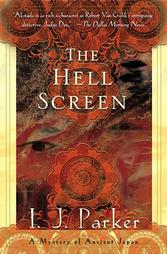 Something that I believe
is great about reading crime and detective fiction is how many facets
there are to it, and what a variety of stories, places and eras there
are for the adventuresome reader, if you’re willing to seek them
out. You can read only cozies if you want to, or only hard-boiled
private eye novels, or serial killer thrillers, but if you want to
diversify, there’s plenty of opportunity out there, in both old books
and new. Something that I believe
is great about reading crime and detective fiction is how many facets
there are to it, and what a variety of stories, places and eras there
are for the adventuresome reader, if you’re willing to seek them
out. You can read only cozies if you want to, or only hard-boiled
private eye novels, or serial killer thrillers, but if you want to
diversify, there’s plenty of opportunity out there, in both old books
and new.When you pick up The Hell Screen, for example, the second case solved by nobleman and minor government official Akitada Sugawara, be ready to travel to a world that’s as just as alien to us as Shira Calpurnia’s in Crossfire up there just above. This one’s ages into the past, however, not the future, and one that takes place in a world just as strange and fascinating, especially to those of us in the western hemisphere, and that’s eleventh century Japan. The story begins with Akitada staying overnight in a monastery on his way home from an assignment as provisional governor of Eichigo in the far north. A young woman is murdered in a room nearby, although he does not learn about it until several days later. And as fate would have it, the superintendent of the police who’s in charge of the case is Kobe, with whom he helped solve a murder at one time before. Although they are friendly, their relationship is still somewhat an adversarial one, in part because of their different social standing. Besides being involved with the murder, Akitada’s success in the north does not carry over well to his return home, where his mother is dying and his two sisters, one married, the other not, have (respectively) a husband and a lover who need Akitada’s sometimes (extremely) reluctant assistance. On page 44, the “complexities of fate” are mentioned – which is another way of saying coincidences of great magnitude – and throughout the book, they seem to follow Akitada wherever he goes. Once the family situations have begun to be resolved, the mystery – which is very briefly a locked room affair – can be tackled in earnest. It gets a little overly melodramatic toward the end, but given the circumstances, which you’ll have to read about yourself, it’s easily forgiven. Parker has a definite flair for describing both place and people, making this trip back into time an absolute delight to see (in one’s mind’s eye). On the not-so-positive side, she does not seem to have quite the same finesse in structuring the words that come from the mouths of her characters. There is a very subtle knack of writing dialogue so that, even though it’s written in English, it still sounds foreign and appropriate to the time and the level of society of the people who are speaking, and Parker hasn’t found the handle on it, or at least – to my ear – not yet. It’s a minor complaint about a book which, based on two real-life cases, is otherwise a solid, substantial effort and vividly done. And in the process of the over 300 pages – and here comes another bonus that crime and detective fiction can often offer as well – Akitada Sugawara learns a little more about life and – although he’s very much happily married – about women. UPDATE.
From I. J. Parker’s website
comes the following list of stories in which Akitada Sugawara has
appeared. They appear chronologically by publication date, not in
the order in which they appeared in Sugawara’s own life.
“Instruments of Murder” Alfred Hitchcock’s Mystery Magazine [AHMM], October 1997. “The Curio Dealer’s Wife” AHMM, November 1997. “A Master of Go” AHMM, December 1998. “Akitada’s First Case” AHMM, July/August 1999. [Shamus award for Best PI Short Story.] “Rain At Rashomon” AHMM, January 2000. “The New Year’s Gift” AHMM, April 2001. “Welcoming the Paddy God” AHMM, December 2001. “Death and Cherry Blossoms” AHMM, June 2002. Rashomon Gate. St. Martin’s Press, hardcover, July 2002. Penguin, trade pb, February 2006. “The O-Bon Cat” AHMM, February 2003. The Hell Screen. St. Martin’s Press, hardcover, September 2003. “The Kamo Horse” AHMM, October 2003. The Dragon Scroll. Penguin, trade pb, June 2005. “The Tanabata Magpie” AHMM, September 2005. Black Arrow. Penguin, trade pb, November 2006. Some comments, more or less at random: I. J. Parker is female, in case you were wondering, as was I, and she is a retired Associate Professor of English and Foreign Languages at an unnamed Virginia university (at least on her website the school is unnamed). Some career difficulties seem to have arisen between her second and third books, with Penguin having come to the rescue. There seems to an accumulation of short stories sufficient for a collection. Perhaps someone with the power to do something about it should take notice. RICHARD ELLINGTON - It’s a Crime Pocket 756; 1st printing, Dec 1950. Hardcover: William Morrow, 1948. Richard Ellington (1914-1980) wrote only five mysteries, and all five featured a Manhattan-based private eye named Steve Drake. This is the second of them, and for the record, here’s a list of all five: Shoot the Works. Morrow, 1948; Pocket #624, 1949. It’s a Crime. Morrow, 1948; Pocket #756, 1950. Stone Cold Dead. Morrow, 1950; Pocket #813, 1951. Exit for a Dame. Morrow, 1951; Pocket #941, 1953. Just Killing Time. Morrow, 1953; Bantam #1286 as Shakedown, 1955. Thanks to the Cook-Miller index to digest mystery magazines, we learn that Ellington also published three short stories in Manhunt and one in Mike Shayne Mystery Magazine. “Fan Club” Manhunt, April 1953. “The Ripper” Manhunt, August 1953 . “Shadow Boxer” Manhunt, February 1954. “‘Good-By, Cora’” Mike Shayne, February 1968  At least the first of
these is a Steve Drake yarn as well. I’m not sure about any of
the others. According to the brief biography of Ellington inside
the front cover of this paperback edition, he was heavily involved with
radio both before and after the war: acting, announcing and
writing. What he ended up doing after the career in writing
mysteries ended I don’t yet know; perhaps writing for television?
(A later search on www.imdb.com
turned up nothing.) At least the first of
these is a Steve Drake yarn as well. I’m not sure about any of
the others. According to the brief biography of Ellington inside
the front cover of this paperback edition, he was heavily involved with
radio both before and after the war: acting, announcing and
writing. What he ended up doing after the career in writing
mysteries ended I don’t yet know; perhaps writing for television?
(A later search on www.imdb.com
turned up nothing.)The cover of It’s a Crime will give you an idea of the kind of mystery it is, or if not, at least it’s a portrayal of the one scene that the people at Pocket thought might sell the book. Paul Kresse is the artist, and in the center foreground is the butt end of a gun being grasped by the barrel (only part of the fingers showing) and being used to clout a man in the head. Side view, tie askew, he’s obviously in excruciating pain. Quoted from the text: “My gun-butt smashed his skull.” Granted that the scene is in the book, and so is another in close proximity of the same guy with a tommy gun, firing away at Drake before he gets away, only to turn the tables, as shown on the cover, but ... Steve Drake is really only medium-boiled, about 6 or 7 on a standard HB (hard-boiled) scale ranging from 1 to 10. I’ll quote Mr. Drake, who tells his own story, from pages 60-61: She was dead, of
course. Just the limp position of the arm hanging over the tub
told me that. Don’t let anyone kid you. It’s only in very
rare cases that you have to listen for heartbeats and feel
pulses. They look dead, they don’t look the way they did
before. If you don’t believe me, go to the morgue, go to a
funeral, go join the police force, wait for the next draft ... What the
hell am I talking about? Okay, it scared me. It made me
jittery. It always does. It would you, too. You might
throw up. You might even faint. I didn’t. But then
I’m a tough guy.
Drake actually has two cases in this adventure. The first is a wandering husband caper. The second is a case of blackmail, the victim being the male half of a famous Broadway husband-and-wife duo. That the two cases are connected comes as no surprise to anyone who has read as many mysteries as you and I, but Drake himself takes it in with a slightly perplexed stride. What is surprising, and it really shouldn’t have been, is that this prime example of lower-echelon tough-guy fiction turns out to have a complex and finely tuned detective story plot to go with it. There are many, many people with access to the dead girl’s apartment, and before her death there were enough of them going in and out that it would take a minute-by-minute timetable to keep it all clear. After the non-essentials have been eliminated, all of the suspects that remain have iron-clad alibis, and takes a huge effort in deduction on Steve Drake’s art to crack one of them. It’s a plot worthy of Ellery Queen, say, without quite the same finesse – relying on what seems like sheer chance on the part of the killer, and of course the aforementioned coincidence that involves Drake in both cases to begin with. It’s a neat double combo, in other words, and very much worth seeking out. I’d especially like to locate my copy of the next book in the series. The love affair that Drake seems to find himself in as this one goes along seems to bloom very quickly, and if I read the last couple of pages correctly, Drake both proposes marriage and the same time he say’s he going to be spending the money he made on this case on a trip to St. Thomas. Does she go too, or will she wait for him patiently at home? These are things an inquiring minds like to know.
December
2003
ROBERTA ISLEIB - Six Strokes Under Berkley, paperback original; 1st printing, June 2002.  What's the strong
connection between golf and
psychotherapy? You may ask, but if you’re like me, you probably
would have never thought of the question until you’ve read this book
and found out the answer for yourself. I’m no golfer, but Roberta
Isleib is, and in her real job, she’s a clinical psychologist, and I’m
oh-for-two. What's the strong
connection between golf and
psychotherapy? You may ask, but if you’re like me, you probably
would have never thought of the question until you’ve read this book
and found out the answer for yourself. I’m no golfer, but Roberta
Isleib is, and in her real job, she’s a clinical psychologist, and I’m
oh-for-two. Her series character heroine is budding LPGA superstar Cassandra Burdette, but her superstardom on the ladies’ professional golf tour will be nipped in the very same bud if she doesn’t qualify by doing well at Q-school. Complicating matters are two murders, one back home in Myrtle Beach, the one on the golf course in Florida where the tournament is going on. Having found both bodies, Cassie is a key figure in the investigation, if not the key suspect, prompting her to – in the true fashion of amateur detectives everywhere – try to find the killer herself. Or are there two? The pending matter of a case of sexual abuse that a fellow golfer has accused her father of – produced by not always reliable retro-memories brought back by hypnosis and other means – seems to be the common factor. But is it? Isleib’s characters have more than enough chicanery up their sleeves to spread the suspicion pretty much around, so it’s not as clear-cut as it may seem. This is, by the way, the Cassie Burdette’s first adventure in mayhem mixed up with golf. There are others on the way, but let me back up a little. I didn’t do a page count, but I think there is more emphasis on the golf than there is mayhem. In terms of an insider’s (fictional) view of how to play the game, how to manage your nerves and keep your concentration, I don’t think I’ve read a better example. In the terms of the murders and their investigation, if I told you I knew who the killer(s) was/were on page 68, you might think I was being totally negative, but I’m not, because (a) I didn’t know how or why, and (b) a couple of chapters later I was convinced that someone else had done it. The plot is not a perfect job of construction. Isleib is awfully skittish is telling us about the first victim, for example, who he was, and how he was involved in the legal case that’s present at the beginning. Let’s get on with it, you feel, while the story is skirting unceremoniously around it. All in all, however, this is pretty good, better than average, you might say, for a maiden effort. Promising, you might also say, and enough so for me to make it a point to follow Cassie and her career in golfing, as her sucess in the latter seems to be opening up new vistas for her. That’s assuming, you understand, that the Jessica Fletcher factor doesn’t start to kick in. With murders continuously following her around on the tour, who’s going to want to be in the same tournament with her?
December
2003
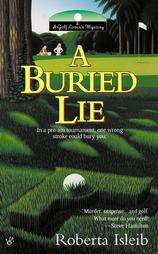 ROBERTA
ISLEIB - A Buried Lie ROBERTA
ISLEIB - A Buried LieBerkley; paperback original; 1st printing, May 2003. So. I did say I was going to be following Cassie Burdette’s career, didn’t I? This follows soon after Six Strokes Under, with Cassie playing in a pro-am golfing tournament on the ladies’ professional tour. With, of course, murder following her. The female member of the foursome of amateurs playing with her on the first day is later found dead. The police believe that’s it suicide, but Cassie, donning her sleuthing clothes, thinks otherwise. What makes the first eighty percent of the book very much a step ahead of Roberta Isleib’s first effort is that there are several possible motives for the crime – the police are wrong, by the way, but I imagine you knew that. (1) The dead woman was in trouble at work, a pharmaceutical company: she has been insisting that something is wrong with the data in their analysis of a new drug product. (2) She was going through an angry divorce, and the proceedings seem have been getting messier. (3) She was a heavy gambler and may have run into problems with the Atlantic City mobsters. And finally but perhaps foremost, (4) the last person Cassie saw her with was a runaway girl whom she was trying to help by taking to her apartment. All of which makes for a sizable amount of detective work to be done. There are always problems in getting an amateur sleuth involved in matters of police business and none of hers, even if the police do not believe there is any business to be done, even in spite of a second murder, so that the bits of awkwardness that keep Cassie involved are essentially a given. It’s the last 20 pages where the author seems to let the story get away from her, in which (1) Cassie, working undercover, interviews for a job at a local escort enterprise, the adult kind. This reminded me of Angie Dickinson in the TV show Police Woman, where she almost always had to disguise herself in every episode as a stripper, an hooker, or a combination of both. (How do I know? I was watching.) Nothing explicit here, though, just some good humor. And (2) a final confrontation scene with the killer, which I can’t tell you about, but it’s certainly one that Nancy Drew never had occasion to be a part of. But I didn’t believe it when I read, I don’t believe it now, and (if you’re still with me) I don’t think I ever will believe it. The characters are fun to be with, however, with lots of foibles and semi-romantic entanglements to make them interesting, and the plot, while implausible, is still coherent enough to keep you (well, me, anyway) looking forward to Cassie Burdette’s next case of felonious mayhem and malice.
December 2003
UPDATE:
Two and a half years later, here is the complete list of Cassie
Burdette mysteries:
Six Strokes Under.
Berkley, pbo, June 2002.
A Buried Lie. Berkley, pbo, May 2003. Putt to Death. Berkley, pbo, April 2004. Fairway to Heaven. Berkley, pbo, March 2005. Final Fore. Berkley, pbo, March 2006. And for what’s coming next from Roberta Isleib, check out the Pro-File interview she did for M*F in May 2006. WILLIAM CAMPBELL GAULT - Night Lady Crest 260; paperback original, 1958. 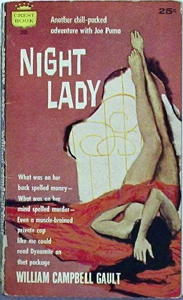 William Campbell Gault
got his start writing for the pulp magazines, beginning around 1940,
maybe earlier, producing not only mystery stories and crime fiction,
but doing a slew of sports stories as well. When the pulps faded
away and paperbacks came along, he, as did many others, went with the
flow. His first Joe Puma novel, Shakedown,
was written under the name of Roney Scott as half an Ace Double in
1953. William Campbell Gault
got his start writing for the pulp magazines, beginning around 1940,
maybe earlier, producing not only mystery stories and crime fiction,
but doing a slew of sports stories as well. When the pulps faded
away and paperbacks came along, he, as did many others, went with the
flow. His first Joe Puma novel, Shakedown,
was written under the name of Roney Scott as half an Ace Double in
1953. Then after a short hiatus came five Puma adventures in three years from Crest, then a hardcover novel, The Hundred-Dollar Girl, from Dutton in 1961. Gault switched to writing boys’ adventure fiction after that, and Joe Puma disappeared until The Cana Diversion was published in 1980 – about which more in a moment. In many ways Joe Puma is your standard medium-boiled kind of private eye. His bailiwick is Los Angeles and immediate environs, mostly the seedier side of town, mixing it up with former small-time hoods, chiselers, grifters and big-time mobsters, along with a wide assortment of women. Night Lady is Puma’s third appearance, and while I can heartily recommend it to any fans of PI fiction, it’s highly unlikely that any publisher would consider reprinting it today. I may totally wrong about this, but in terms of his writing, Gault seems to have been somewhat of a maverick, refusing to go along with the conventional, and veering off on occasion into strange, unusual ground. Take the following excerpt from the first couple of paragraphs from Night Lady, as a mild example. As any good pulp writer should know, the first few lines are the most crucial in sucking the reader into the story. They have to be good, clear, and picturesque. Not this time. Here’s Gault’s take on professional wrestling and the wrestlers themselves: It’s a trade that appeal [sic] to the narcissist. And from
self-admiration it’s only a step to love of like for like.
And love of like for like can lead a man into something as socially responsible as Rotary or something as socially repugnant as homosexuality. What is “love of like for like”? It stumped me the first time I read it, and the second and third time, too. The words were there, but they didn’t make sense. You’re probably way ahead of me in knowing what Gault was saying, but to me, it was like running a race with hurdles, and suddenly the hurdles are too close together, you trip, and you knock down the next one, and suddenly you’re cartwheeling down the track, arms and legs swinging out in all different directions, thud, thud, thud – and it stopped me cold. And at the least, I wasn’t expecting this particular variety of deeply felt philosophy to be expressed so abruptly, not in the first paragraph. It caught me by surprise. I wasn’t an English major in college, and I avoided all of the English courses that I could, so don’t give me a letter grade on any of what I’m saying, but in any case, I think I flunked the first page. You’ve also noticed the reference to homosexuality. In terms of either political correctness or just plain good taste, there are some references to gays in this book that probably would cause some fuss if they appeared in most fiction today: lavender lads (page 9), weirdies (page 11), a pansy bed (page 14), homo (page 29) and the old stand-by, queer (page 49). The word “gay” itself is not used. Sometimes it’s Puma talking, sometimes it’s the people he’s talking to, without any particular rancor, other than the choice of words, but they’re there and they can’t be ignored. Someone else will have to finish this doctoral dissertation from this observation onward, however, not me. You’re still waiting for me to say more about The Cana Diversion, perhaps. I haven’t forgotten, but let me first take care of those people who want to know more about the case Puma is working on in this book. He’s hired by a successful show-business wrestler named Adonis Devine to find his business manager, who’s been missing for two days. The business manager, male, also lives with Adonis, which means calling in the police may cause some problems. When the missing man is found dead, the police do have to be called in, but since Puma does his best to stay on the good side of the law, he not only manages to keep a lid on things best kept hushed up, but he’s allowed to keep working on the case. Which he does, and not only that, he obtains a new client, a rich girl who Puma thinks is seriously slumming, given her previous relationship to the dead man, his connection with the crooked (well, fake) wrestling entertainment business, and his “double-gaited” life style. There is another girl involved as well, an eye witness to the killer’s departure, who is nice and who naturally needs Joe Puma’s protection. He’s kind of prickly about it, though. He’s a very class-conscious sort of individual. The women in this case, especially his new client and her friends, are high class group of people. Joe is lower middle class, and he quietly resents it. There is a chip on his shoulder throughout the book, not a nasty one, but a noticeable one. Unusual. It gives the story some oomph that lesser accomplished private eye writers wouldn’t include, an edge that Gault has that other authors don’t. As for the mystery itself, Puma does a lot of detective work, but on page 128, with less than 30 to go, he himself has to admit that he has no more leads to follow or suspects to interrogate. Then with some inspired guesswork and a curious slip on the part of the killer – there’s little the armchair detective at home could do to contribute – the case is solved, with still almost ten pages to go. More of Gault’s maverick writing nature at work. Instead of cleaning up the loose ends, as he easily could have, Puma takes the time instead to fight a grudge match with his original client, Adonis Devine, the wrestler. Over five pages worth. 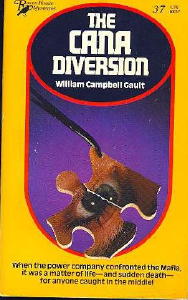 He also ends up in bed, just before that, with one of the two women in the case. I leave it to you to decide which one, or read the book for yourself. Given the caveats I’ve already expressed, Gault was a writer who always had something to say, and here as well, he’s definitely worth reading. Now. If you’ve never read The Cana Diversion, and you think you might want to, you might also want to stop here. It’s common knowledge, though, so it’s not as though I’m releasing the Pentagon papers. Gault’s other private eye detective was Brock “The Rock” Callahan, and when Gault starting writing mysteries again in the 1980s, he brought them together in the same book, The Cana Diversion. Unfortunately, what he did was make Puma the murder victim, leaving Callahan the task of tracking down his killer. No other author has ever done this, before or since. I don’t know about you, but the idea has always seemed awfully creepy to me, and I’ve never read the book. (That’s a purely personal reaction, and if I were to try to explain further, it would probably tell you more about me than either you or I would want to know.) And I realize, of course, that this leaves me open to widescale expressions of surprise and disdain, if not derison and dismay. In 1983 The Cana Diversion did nothing less than win the Private Eye Writers of America award for the Best Paperback Original of the Year. Sometimes it pays to go your own way. Note: Thanks to Bill Crider, Richard Moore and Bill Pronzini for some insightful commentary they made on some preliminary versions of this review. The opinions as expressed above, however, remain as always, mine alone.
December
2003
MARGARET FRAZER - The Bastard’s Tale Berkley Prime Crime. Paperback: January 2004. Hardcover: January 2003. This is the twelfth in Frazer’s ongoing series of medieval mysteries, all with Dame Frevisse as the leading character, and given that her primary residence is the nunnery at St. Frideswide’s, England, it’s not easy to say how she’s happened to become involved in as many cases of murder and intrigue as this. And if you don’t know, I’m not the one who’s going to be able to tell you – this is the first of her adventures I’ve happened to read – but it’s also not difficult to realize that in that particular time and place of the world, death came both more easily and more often. So given the controls of a time-traveling machine, I’d not inclined to be heading back to this particular era any time soon, but in fiction, it’s fine, and so is the book. If you like historical mysteries, you shouldn’t allow Frazer’s series slip by you for as long as I did. It’s my error, all the way. 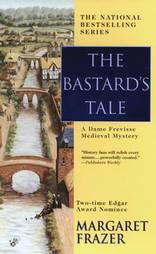 The year is 1447, the
25th year of reign of Henry VI’s, and as I gathered from the story, at
the time he was only just over the same age himself. (Let me
insert a confession here, if I may. I obviously was not paying
close enough attention back in high school. History classes
barely caught my awareness level, especially British history, and it’s
starting to show.) The year is 1447, the
25th year of reign of Henry VI’s, and as I gathered from the story, at
the time he was only just over the same age himself. (Let me
insert a confession here, if I may. I obviously was not paying
close enough attention back in high school. History classes
barely caught my awareness level, especially British history, and it’s
starting to show.)The character described in the title is Arteys, the illegitimate son of Humphrey, duke of Gloucester, and the Henry’s “well-beloved uncle” – although the king, under the influence of the marquis (formerly earl, later duke) of Suffolk, has a strange way of showing it. To the contrary, he has recently accused Gloucester’s wife, Lady Eleanor, of witchcraft and trundled her off to prison, not an ideal way to keep peace in the family. www.imdb.com While there is eventually a murder in this novel, or at least an attempt, there is very little question of who ordered it. There are a few pages of investigative activity on the part of Frevisse and the two others assisting her: Joliffe, a man of many past roles, now an actor who is part of a troupe entertaining the king’s entourage; and the singularly non-ambitious but exceedingly observant Bishop Pecock. Overall, though, the amount of actual detective work going on is minimal. It is the intrigue, the constantly shifting of alliances for the power behind the throne that the story is about, along with the characters that Frazer brings so strongly to life. And she somehow does it by keeping the major players, those known to history, more or less in the background. What Frazer does very nicely is to describe events from the point of view of the common people, who sense as they do that something’s going on, but who have as much effect on the day’s events as a butterfly in a snowstorm. Frazer’s focus is on everyday activities, but she also manages to keep the big picture well illuminated – and what’s more, she makes it look easy. There is the constant feeling that powerful forces are hard at work here. The link between the two worlds is Dame Frevisse, who walks in both of them. Somehow she’s comfortable both in her life as a nun and in the confidence of the aspiring Suffolk’s wife, who is also her cousin. In the grand scheme of things, Frazer is limited to and restricted by actual events. She can’t change history, which goes without saying, but if she were to have followed the usual conventions of story-telling, it’s easy to see how the story might have come out quite differently. Arteys, for example, when his demanding role in the story is over, disappears far too soon – but precisely as he did in the annals of history – as much as she or the reader might wish otherwise. (The reader, perhaps, even more so.) Looking over the notes I made as I was reading, I see that I said to myself “very good” several times. I’ll let that be the summary as well. Very good. Very, very good. PostScript: Margaret Frazer began as the joint pseudonym of Mary Monica Pulver (a.k.a. Margaret Ferriss) and Gail Frazer, but after the first six in the series, it’s the latter who’s been writing them alone, including this one. The novels also started out as paperback originals, but they’ve apparently done so well that they’ve switched to coming out in hardcover first.
December
2003
_____________________________________ YOUR COMMENTS ARE WELCOME.
Copyright © 2003 by
Steve
Lewis. All rights reserved to contributors.
Return to
the Main Page.
|
